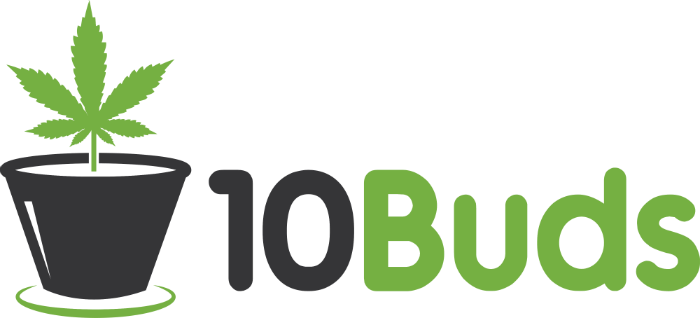All about Cannabinoids: Everything You Need to Know
A Guide to the Cannabinoid Compounds CBD, THC, CBN, and CBG.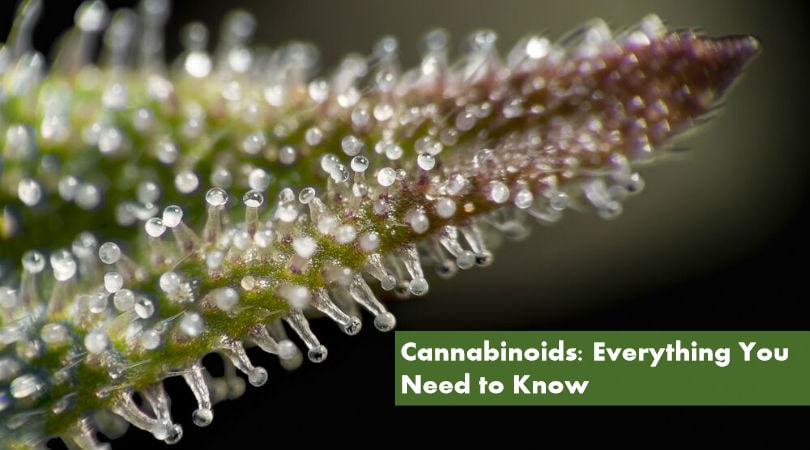 Whether you are totally new to the world of cannabinoids or have already begun to explore the topic, the following details will provide you with additional information to meet your needs. Learn more about CBD, THC, CBN, and CBG below, regarding what each compound is, their health benefits, and the implications for the future.
Whether you are totally new to the world of cannabinoids or have already begun to explore the topic, the following details will provide you with additional information to meet your needs. Learn more about CBD, THC, CBN, and CBG below, regarding what each compound is, their health benefits, and the implications for the future.
What are Cannabinoids?
A class of chemical compounds that naturally occur in the cannabis plant are called cannabinoids. These compounds are formed in sticky structures called glandular trichomes. Just one trichome has a range of types of cannabinoids.
The active compounds are diverse, with different ones being used for medicinal or recreational purposes. The different compounds look and function differently from one another. You may sometimes hear cannabinoids also referred to as phyto-cannabinoids and exo-cannabinoids.
So, depending on the compound, and your intention for ingesting it, the cannabinoid could help to heal you or get you high instead. The cannabinoids come together with compounds that are similar to those found in the body to provide these effects. Cannabinoid testing occurs daily in labs around the globe to determine how to provide patients with the most advantages from the Cannabis plant.
Of the roughly 500 natural compounds in the Cannabis plant, at least 113 are cannabinoids. While some of these cannabinoids give you a buzzed feeling because of their psychoactive properties, others do not. Two psychoactive cannabinoids that you are likely to hear about are THC and CBD. Here is more about them.
THC
Tetrahydrocannabinol or THC for short is well known primarily for its ability to make you feel high or euphoric. THC is probably the best known of the compounds in the Cannabis plant. It can affect your perception, mood, consciousness, and behavior.
The majority of marijuana strains available for sale are cultivated with high levels of THC to provide users with that desired high. This sense of well being occurs because THC stimulates a part of the brain that triggers the release of dopamine.
When ingesting THC, users can experience relief from pain. In addition, THC has anti-inflammatory benefits. Pharmacologists are investigating how THC-A, the acidic kind of THC, links to anti-prostate cancer too. But, while THC can have therapeutic benefits, ingesting it can also make you feel paranoid and anxious, especially if you are a new user. It is also known for increasing your appetite.
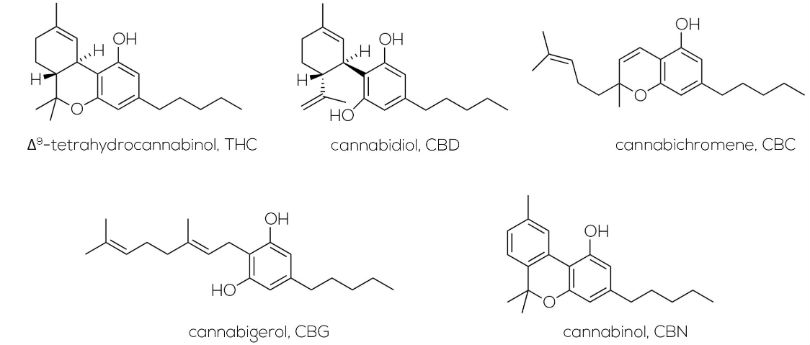
CBD
CBD is the second-most popular cannabinoid in marijuana. CBD stands for cannabidiol, and it is not psychoactive. In fact, it achieves the opposite effect of THC by calming you down rather than taking you to a higher place emotionally. Often CBD is used in discussions of medications, with it being positioned as an alternative medicinal technique. For example, CBD is used in treating Dravet syndrome; it is sold under the drug name Epidiolex.
CBD has been touted for its medicinal uses, including helping protect the body’s neurons from damage or erosion, as well as being useful in anti-inflammatory applications. This intriguing compound can help provide users with relief from arthritis, migraines, epilepsy, schizophrenia, and spasms. Some people use it for as a muscle relaxant. Researchers are currently investigating the potential benefits of incorporating CBD into anti-cancer treatment plans and to benefit heart health.
Due to its potential medicinal benefits, CBD-rich strains are making a comeback. While most strains over the past 30 years have been high in THC, with less than one percent containing CBD, this trend appears to be changing. The reason is because of the medicinal benefits of CBD being studied in labs across the globe.
CBN
Cannabinol, which is better known as CBN, is created by an oxidization process involving THC. While it has psychoactive properties, it is less so than THC. For this reason, when users primarily take marijuana to feel buzzed, they typically prefer strains with more THC, rather than CBN. Also, when CBN is found in large amounts in a strain, taking it can make you feel groggy.
CBN does, however, help lower anxiety and it can even lower the pressure behind the eyes. The effects of CBN are said to be sedative-like. Users can also get relief from muscle spasms with CBN.
CBN comes from cannabigerolic acid. By combining CBN with THC, some users experience less of the anxiety that they feel with high THC levels. CBN may help promoted a deeper sleep than might otherwise be obtained.
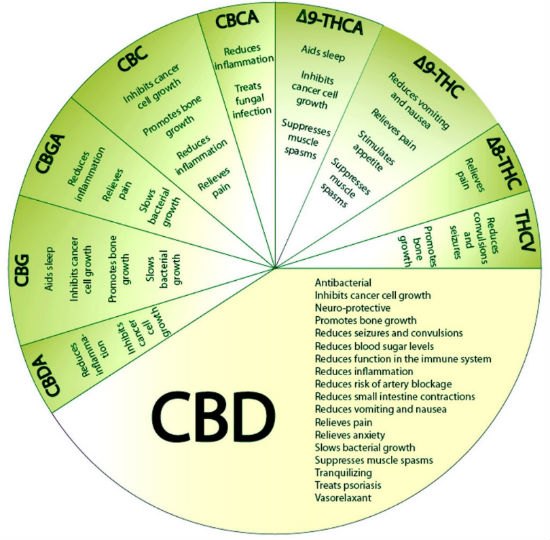
CBG
Another active compound in cannabis is CBG or cannabigerol. It is perhaps best known for having anti-bacterial, anti-microbial benefits. You will not likely find it often though in most pot strains on the market. Instead, you would find CBG more often as a starting point of sorts for THC and CBD. In other words, THC and CBD begin as CBG.
Taking CBG has been found to lower the body’s ability to accept GABA, which causes that mellow feeling often linked with CBD ingestion. The exact nature relationship between CBG and GABA interests researchers, who continue conducting studies to determine the variables and details of the link. Also, CBG has been found to lower intra-ocular pressure (IOP) glaucoma.
Other Types of Cannabinoids
Additional cannabinoids are tetrahydrocannabilolic acid (THCA), tetrahydrocannabivarin (THCV), cannabichromene (CBC), cannabidiolic acid (CBDA), and cannabidivarin (CBDV). We hope to do another article in the near future on these other compounds, which are typically less prevalent in cannabis culture.
How Cannabinoids Work
But, you may ask, what is the link between cannabis and feeling high? Good question. Interestingly, your body creates its own cannabinoids, which are similar to those found in the Cannabis plant, within the endocannabinoid system (ECS). This bodily system has many vital roles, including emotion, sleep, and appetite. The chemicals in cannabis, called cannabinoids, activate cannabinoid receptors that are naturally found in the body.
Cannabinoids work by acting together with certain receptors in the body. The affected receptors are in the immune system and central nervous system, amongst other parts of the body.
There are two receptor types that cannabinoids activate. They are CB1 receptors and CB2 receptors. While CB2 receptors are in the immune system, CB2 receptors are in the brain, nerve endings, and nervous system.
When certain cannabinoids enter your body, as you ingest pot, they appeal to different cannabinoid receptors. For example, THC attaches itself to cannabinoid receptors and activates the endocannabinoid system. THC activates CB1 receptors in the brain, which explains why the user then feels a high.
While CBD does not ‘fit’ perfectly with CB1 or CB2 receptors, researchers are still studying its indirect effects. As for CB2 receptors, CBN does affect them.
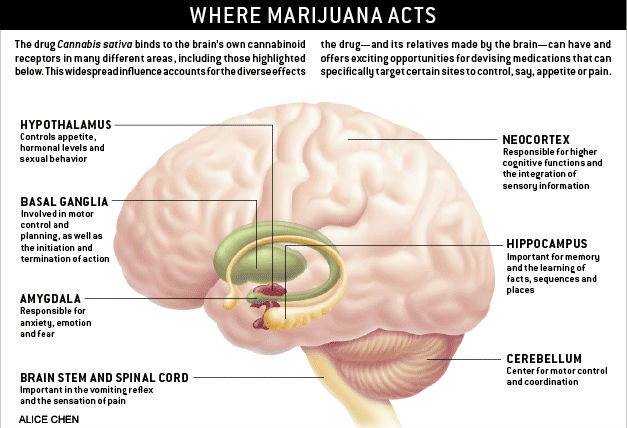
Health Effects of Marijuana
Given the above discussion, the health effects of marijuana are clear. Depending on the active compound(s) in the strain of pot ingested, and the amount of each compound in the strain, the user can experience very different benefits. The cannabinoid ratio can be regarding THC:CBD, for example. A 1:1 ratio of THC:CBD may help with pain control and muscle spasms. The therapeutic implications of this particular ratio are the focus of recent research.
From being a sleep aid to providing pain relief, marijuana has many advantageous effects. It can help relieve anxiety, reduce inflammation, lower muscle spasms, and slow bacteria growth.
Of course, when abused or overused, pot can trigger a dependency and impair both your emotions and memory. But, with responsible use, marijuana has many scientifically-backed benefits. And, there is still much to understand the therapeutic potential of cannabis; researchers continue to conduct clinical trials to learn more about this fascinating subject.
In addition, as with anything, not everyone responds the same way to marijuana. While it may help with difficult health conditions of some people, it may not benefit another person the same way, if at all.
The Future of Cannabinoids
Commercially available cannabinoids are likely to become more prevalent; two approved drugs that are currently available are nabilone and dronabinol. As more research is done on cannabinoids and cannabis genetics, including its ability to benefit in the treatment of epilepsy and cancer-related side effects, you are likely to see more medicinal drugs incorporating the chemical compounds of cannabis.
Research on cannabinoids ranges from physiological studies to biochemical and chemical varieties. The view of cannabis as more than just something that gets you high is increasing amongst North Americans. Cannabis as medicine is a strengthening viewpoint of people, from politicians to celebrities and people just like you and I.
Whether pot is taken for its medicinal benefits or to achieve a high, what is clear is that marijuana is becoming a part of U.S. society more and more each year. As marijuana dispensaries crop up across more of the States with each week that goes by, many Americans are embracing a pot-friendly lifestyle. Given the scientific evidence backing the benefits of cannabinoids in marijuana, we think that is a good thing.
Related Pages: Best Medical Seeds 2019
